As a livestock farmer, if you want to earn better profits, you have to manage your pasture. Managing your pasture offers you several significant benefits.
This is precisely why I wrote you this free guide. To help you answer all these questions:
- Why should you manage your pasture?
- What are the different types of pasture?
- How to choose a pasture that is right for you?
- What should you plant, and when should you do it?
- How to manage your pasture across the different seasons?
- How to fertilise your pasture paddocks for optimal results?
- How to manage rotational grazing schedules across paddocks?
- How to store surplus pasture as silage?
- Is there an automatic, accurate and cheap way to measure your pasture?
- How to effectively manage your pasture, for less than $15 per hectare per year?
1. Why should you manage your pasture?
So, let's start this off by gifting you a trophy, as I'm about to explain why you should take more steps to better managing your pasture.
One, it helps you increase your profits. Two, it helps you raise healthy animals. And three, it helps you become more sustainable.
You’re probably asking, all this sounds good, but where do I start? How do I manage my pasture? What type of pasture should I manage? How to ensure that my animals get enough nutrition?
Managing your pasture can help you increase your profits by saving you money on feed. A recent study by Pasture-Fed Livestock Association and AHDB show how farmers can improve their profits by raising sheep and beef on pasture alone.
Another study by Beukes et al. 2019 shows how you can improve your profit margins by 15% to 19% just by measuring and managing your pasture.
Now, there is also conclusive evidence that shows grass-fed animals are healthier than grain-fed animals. In turn, the milk and meat produced by pasture-fed animals, offer humans several health benefits and therefore command premium prices, which in turn further increases profits.
And finally, grass-fed beef and dairy systems offset greenhouse gases, significantly. This helps you be a part of the solution rather than contribute to your industry’s biggest problem.
I know that you have several questions swimming in your head right now and we're going to attempt to answer them in this document.
TO LEARN MORE ABOUT HOW GOOD PASTURE MANAGEMENT CAN YIELD BETTER PROFITS, READ:
2. What are the different types of pasture?
But, grass is grass, right? Wrong.
So let's categorise them based on what they can offer you.
Let’s call anything that grows on its own on your land as native weeds. Typically, undisturbed temperate grasslands may have more than a hundred species of native grasses, lilies, daisies, sedges, rushes and herbs.
Some are useful, some can be a bother, and the rest exist seasonally without too much benefit or harm.
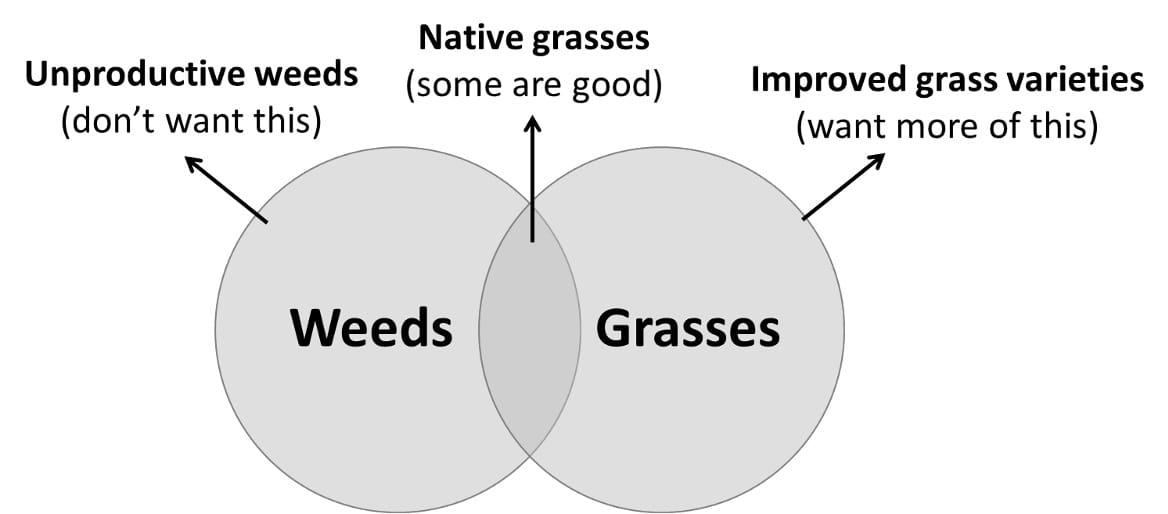
For our purposes of managing a healthy pasture, we are primarily interested in native grasses, improved grass varieties and other forage crops.
Native grasses: Are usually semi-permanent grasses that adapt themselves to your local climate. To manage effectively, you need to understand their growth cycles and how grazing affects their regrowth.
They are usually more resilient than any species you can introduce. This makes them especially useful in times of extreme weather events such as droughts or floods.
Improved pastures: In addition to native grasses, you would ideally want to introduce a high-quality fodder crop such as lucerne, white clover or ryegrass. This will help you increase nutritional value as well as get a higher yield of dry matter per hectare.
However, harsh weather events, such as drought and floods, may significantly reduce yields. And you’ll need to maintain them a lot more when compared to the natives.
Other forage crops: In addition to having improved pastures, you can also consider growing forage crops such as corn, sorghum and even leguminous trees. Together, they will further boost your dry matter yields.
Forage crops can also give you an additional feed buffer, especially during extreme weather events such as droughts or floods.
3. How to choose a pasture that is right for you?
Native grasses, improved pasture varieties and forage crops all play a crucial role in ensuring adequate nutrition for your animals.
Together, they assure you some yield during the bad seasons and surplus yield during good seasons.
Plan to have native grasses that make up 30% to 50% of your ground cover and leguminous crops that make up at least 25% of your ground cover.
However, depending on your local climate and soil profile, this may vary significantly.
For instance, drier regions might need more leguminous ground cover, so that shrubs don’t take over. And cooler regions can afford to have more native grasses and still produce significant dry matter yields per ha.
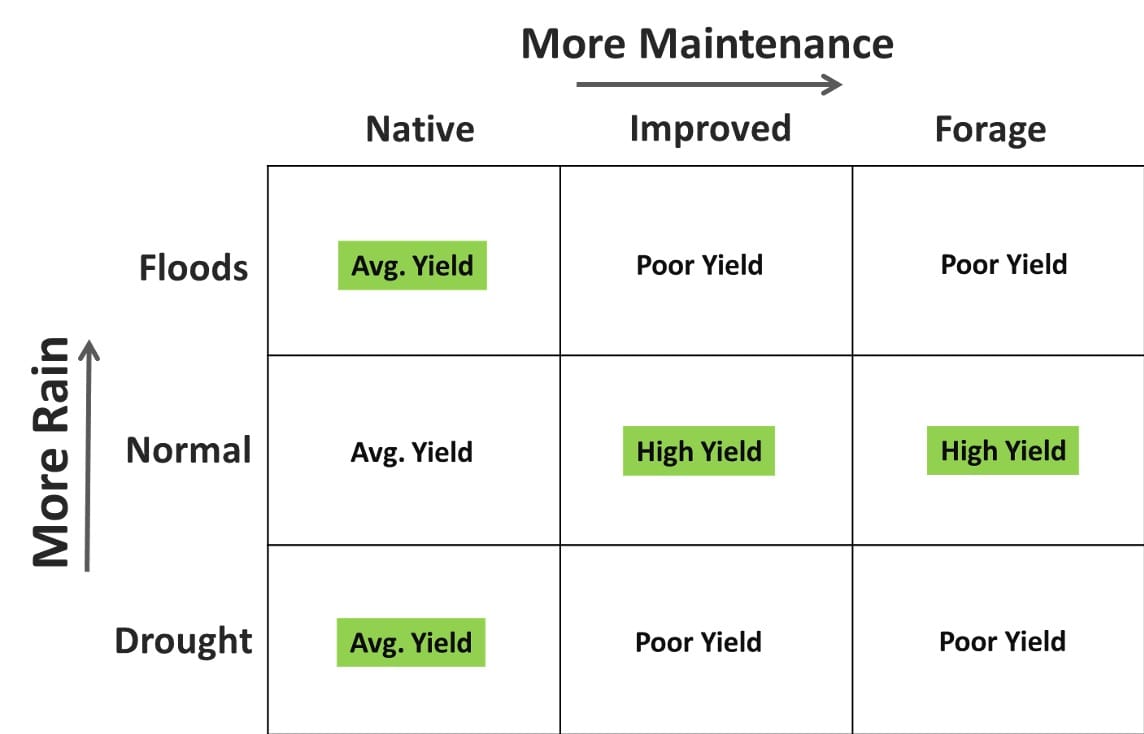
During extreme weather events such as droughts or floods, your improved species may yield very little, but the native grasses and forage crops might save the day.
On the other hand, improved grass varieties may help you take maximum advantage of the good seasons, and help you store the surplus for a rainy day.
Ideally, you should aim to grow mostly improved pastures along with some native grasses on all the paddocks you can afford to provide some irrigation. And let the native grasses to flourish in the other paddocks.
Then plan your forage crops in such a way that you can access some of them without walking more than 300 meters. If designed well, they can also double up as shelterbelts, windbreaks, and crop breaks.
TO LEARN MORE ABOUT PLANTING IMPROVED PASTURE SPECIES, READ:
4. What should you plant, and when should you plant them?
Native grasses typically have a set seed production pattern. Some of them produce seed on an annual or bi-annual basis while others produce seed when there is enough moisture, often in response to seasonal rain.
So working with this pattern is the most cost-effective way to propagate native grasses.
Here are a few native grasses for you to consider: Kangaroo grass (Themeda triandra), wild sorghum (Sorghum leiocladum), spear grass (Austrostipa species) or even Bermudagrass.
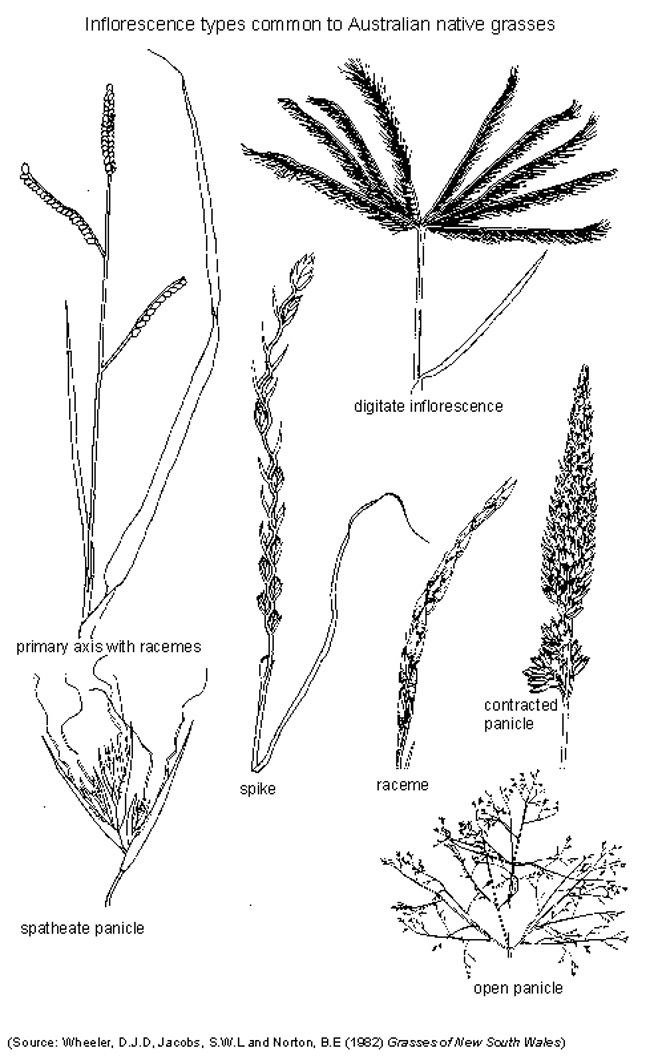
But, for most farmers, given their low dry matter yields per hectare, sowing native grasses can be an expensive proposition.
This is why farmers prefer to sow improved leguminous varieties such as alfalfa, lucerne, fescue, and clover.
In addition to this, you can consider sowing some corn, millets and hardy legumes in smaller areas, as forage crops that need to be managed.
The best time to sow improved varieties, as well as forage crops, is during spring because your pastures will be ready when you need it the most, during summer.
In some cases, where you need to contain weeds and reseed extensively, you can consider doing this during autumn.
Autumn sowing can be preferential in some environments due to the warm soil and autumn rains that can produce a well-established pasture for the winter and spring growth.
5. How to manage your pasture across the different seasons?
Managing your pasture, in the same way, all year round – simply isn’t enough.
It is not enough if you want to get a dense and nutritiously rich pasture.
Each season offers you unique opportunities to improve your pasture.
Generally, farmers are aware that they need to prepare their pasture management for the different seasons. The winter is usually spent feeding the animals and recovering accumulated losses as a result of the year.
In contrast, the spring spent on grazing by cutting and removing forage from pastures. The summer is used for intensive farming because the pastures are restored to sound quality.
The major challenge with pasture management is that many problems are not addressed and can be overcome with proper planning and execution of grazing decisions. Making appropriate management of pasture plans is essential to consider the region in which you live. In some world areas, farmers take advantage of grazing and cutting at various stages depending on their market targets and selling prices.
However, you should consider two general guidelines: One being to reduce animal impact while keeping productivity high and treating pastures with practices such as minimum-tillage management. It is important to note that a good pasture fence can control the animal impact on pastures and use a planned grazing system to rotate animals around different paddocks to graze at varying intensities.
In spring, plan intensive grazing routines because this is your most productive season. Intensive grazing in spring will also increase pasture and milk production for summer.
In this regard, it is also worth noting that intensive grazing routines in the spring will support milk production for summer.
In summer, evaluate your pasture. Ensure that you observe how much bare ground you have, how much more ground coverage you need, and how much weed growth is there in your pasture.
Managing your pasture grazing routines in the spring and winter will help increase your pasture for summer and milk production in the summer.
It's also crucial that you don't overgraze your paddocks during summer, as this can slow down recovery in the following seasons.
Slightly off-topic but essential to mention is that the heat intolerance of livestock is classified as significant health, productivity and welfare issue for many years. This problem is encountered by various regions where farmers are struggling to deal with this issue. According to research, heat stress can be an issue that can impact up to 60% or more of all dairy cattle populations.
The primary causes of heat-related death for cows are:
- Cows not drinking enough water - exaggerated dehydration caused by hot weather
- Regulatory issues such as mastitis and ketosis
Dairy farmers must take the following precautions during hot weather:
- Ensure a healthy and sufficient water supply for the cows at all times
- Provide shade for the animals from direct sunlight
In autumn, start preparing your pasture for wintertime resting and then spring renewal.
If you do not have the desired ground coverage, it is best to slow your grazing round to ensure pasture cover catches up. This practice will ensure that your next season will be as productive as possible.
This period is also an excellent opportunity to reseed your fields if needed. It is also a perfect time to think about weed management.
The autumn is the time farmers should start preparing for winter. During this period, grazed pastures are usually allowed to recover from feeding the animals during the harsh cold winter season. The temperature at night is also intense and can go down below zero degrees Celsius making it difficult for animals to survive without an adequate food supply.
Finally, during winter, you will take a break from grazing. And will mostly be feeding your animals with fodder. This season is a time for reflection and planning, for you to come up with new plans and farm improvements.
To continue grazing during the winter, residual pasture that livestock did not utilise during autumn should be topped. This practice can help to a certain extent. Still, if abnormal climatic conditions occur or prolonged heavy snowfall occurs, it will most likely be challenging to survive without supplementary feed.
In these conditions, extra feed that will save the day in case of severe winter conditions can assist farmers in improving their ability to survive harsher winters by putting hay and feedstuff such as maise silage into fodder banks.
If you do not have a pasture as dense and nutritiously rich as you want, please reach out to us. We can help you meet your needs with our satellite pasture measurements and grazing management practices enabled through our farm app.
We will help you manage your paddocks to be more productive for your animals and the environment.
In this way, we strive to be at the forefront of pasture management efficiency wherever you are farming. We believe in responsible farm management that benefits everyone involved in agriculture today and tomorrow. We work with farmers who share our ideals of sustainable farming methods.
The seasons of the year have a significant impact on the management of pastures. However, there are some significant challenges that farmers face concerning pasture management. The most common issues faced in this area are related to grazing decisions and considering the region in which you live.
To correctly manage your pastures, it is crucial to consider each season in advance and prepare for them accordingly.
TO LEARN MORE ABOUT MANAGING YOUR PASTURE ACROSS DIFFERENT SEASONS, READ:
- How to Manage Your Pasture By Seasons
- Three Amazing Warm Season Grasses
- Timely Grazing: Key to Effective Spring Pasture Management
- Managing Perennial Ryegrass for Spring Growth
- Grazing tips for winter conditions: "wait, you feed out on the road?
- Winter Grazing Tips: Who Left That Gate Open?
- Stop eyeballing your pasture growth and start earning more profits
6. How to fertilise and maintain your pasture paddocks?
It might not come to much of a surprise that fertilising paddocks is a bit more than rotating grazing paddocks and spreading manure on the soil.
Today, most soils lack several nutrients, and without the correct fertiliser, pasture growth is feeble.
Monitoring soil fertility is the first step in realising lost opportunities in your farm business.
Only when you've tried it yourself, do you realise how important it is to get your soil regularly tested so that you have a good understanding of what your paddocks need for growing forage of high quality.
Unlike nitrogen and phosphorus, three other elements in the soil that are important for plant growth, potassium, sulphur & calcium, are not readily available to plants when needed. This characteristic makes them less mobile than other nutrients like nitrates and phosphates. Over time these become tied up by natural processes such as weathering or plant into the soil. This process is because these nutrients will slowly become less available to plants, forcing the plant into an emergency state.
Unfortunately, it is only in an emergency stage that they have enough energy to start processing and absorbing them from the soil- so by this time, it's often already too late!
How does fertiliser help?
A quality fertiliser usually contains all three minerals mentioned earlier and, very importantly, includes trace elements.
These are important for healthy growth and production. Without these nutrients, many problems arise, including low fertility and reduced disease prevention.
Fertiliser not only replaces depleted nutrients but replenishes what was there, to begin with, plus more, and it helps you grow better grass!
For optimum pasture growth, you need all the essential nutrients in sufficient quantities.
Nutrient deficiencies can limit pasture growth, even if other nutrients are available. Therefore, as discussed, it is necessary to test your soil for nutrient deficiencies.
Only then can you use fertilisers correctly.
Proper fertiliser use can help you increase pasture production and improve pasture quality. It can also enhance the tolerance of your pastures to grazing and drought.
Using fertiliser the right way will help you achieve:
- More grass per hectare, with more leaf and stem growth.
- Better pasture condition – a greener sward is usually healthier.
- Higher quality homegrown feed that is nutrient-dense.
In some cases, proper fertiliser use might reduce weed levels, improve pasture water use efficiency and reduce runoff and erosion.
Because livestock farms graze paddocks quickly and rapidly, they can degrade quickly in a few seasons. This activity can even lead to severe deficiencies in your animals and poor soil fertility in the long run.
So, if you want sustainable farming that considers natural processes and improves the land while producing healthy food for your animals, then turn to nature's fertiliser – dung. Otherwise, synthetic fertilisers can be environmentally friendly when utilised sensibly.
You can use a high-quality organic fertiliser such as dung to replace synthetic fertilisers and manure management practices that rely on additives such as ash, urine or compost.
Buying in dung is not always an option if the supply is thin or the price is too high to meet market conditions.
Anyway, dung provides nutrients for growing healthy pasture, nourishing your livestock, transforming the manure into a valuable resource. This process encourages land regeneration and keeps the life cycle running smoothly, so you get healthier stock with less work while minimising chemical use.
There is no single best way to spread the fertiliser. Some people prefer rotational grazing techniques where cows move from paddock to paddock (sometimes via a central holding paddock) rather than continue feeding them in one place. However, the most crucial factor is ensuring that your pasture is rested enough between grazing so it can grow at the same rate as your animal needs.
Since livestock prefer lush, young grass to older, tougher grasses with a low nutritional value that they can't digest, it's essential to focus paddock rest times or rotations around the growing cycle of your pastures, not on what you need for feed production only.
Strongly stock-dependent farmers may require more supplementary feeding than those where livestock are less intensively managed. Of course, there is no 'one size fits all' here – but aim to create a rotation that suits the animals and land conditions.
It would be best if you were aiming to optimally supplement your soil in a sustainable manner that produces the best environmental outcomes for a sustainable farm system.
There are several key concepts to remember when developing an NPK fertiliser program for your farm.
These include:
Soil tests will be critical in determining the need for N, P and K application rates. Even if rainfall is regularly above 400mm per year (and even higher than this), soil tests should still carry out each year. The aims of conducting soil testing are different from those outlined by other agricultural advisers who encourage farmers to get onto "soil health" programs (who seem more focused on getting farmers off chemical applications).
In our view, soil testing programs such as these do not consider the full range of factors that could influence nutrient uptake by plants, including not taking into account that plants can also take up nutrients directly from the air.
It is vital to regularly check N, P and K levels are meeting requirements in your soil (based on recommendations from professional advisers). This monitoring will help you ensure there is no nutrient deficiency or toxicity in irrigated pastures.
To prevent over-fertilising soils, splitting rates over several years is recommended. Over time you should aim to decrease the amount of fertiliser applied each year by adjusting application rates based on the needs of changing plant communities.
So, for optimal results, ensure you do your soil tests, apply the recommended dosage of fertilisers and continue to monitor nutrient deficiencies.
TO LEARN MORE ABOUT THIS, READ:
7. How to manage rotational grazing schedules?
When you want to graze your animals across several paddocks, it is apparent that you need to follow some kind of rotational grazing plan.
But, what will you base this rotational grazing plan on?
The easiest option is to implement a time-based rotational grazing plan.
That is grazing a paddock again only after the other paddocks have been grazed in a particular sequence. So you will effectively be grazing paddocks based on the last date it was grazed.
While this sounds intuitive and logical, it has its limitations. For instance, pasture growth differs from paddock to paddock, depending on slope, soil quality and available moisture.
This means that there is always scope for you to make better grazing choices.
Measuring your pasture and grazing based on this data offers a real competitive advantage.
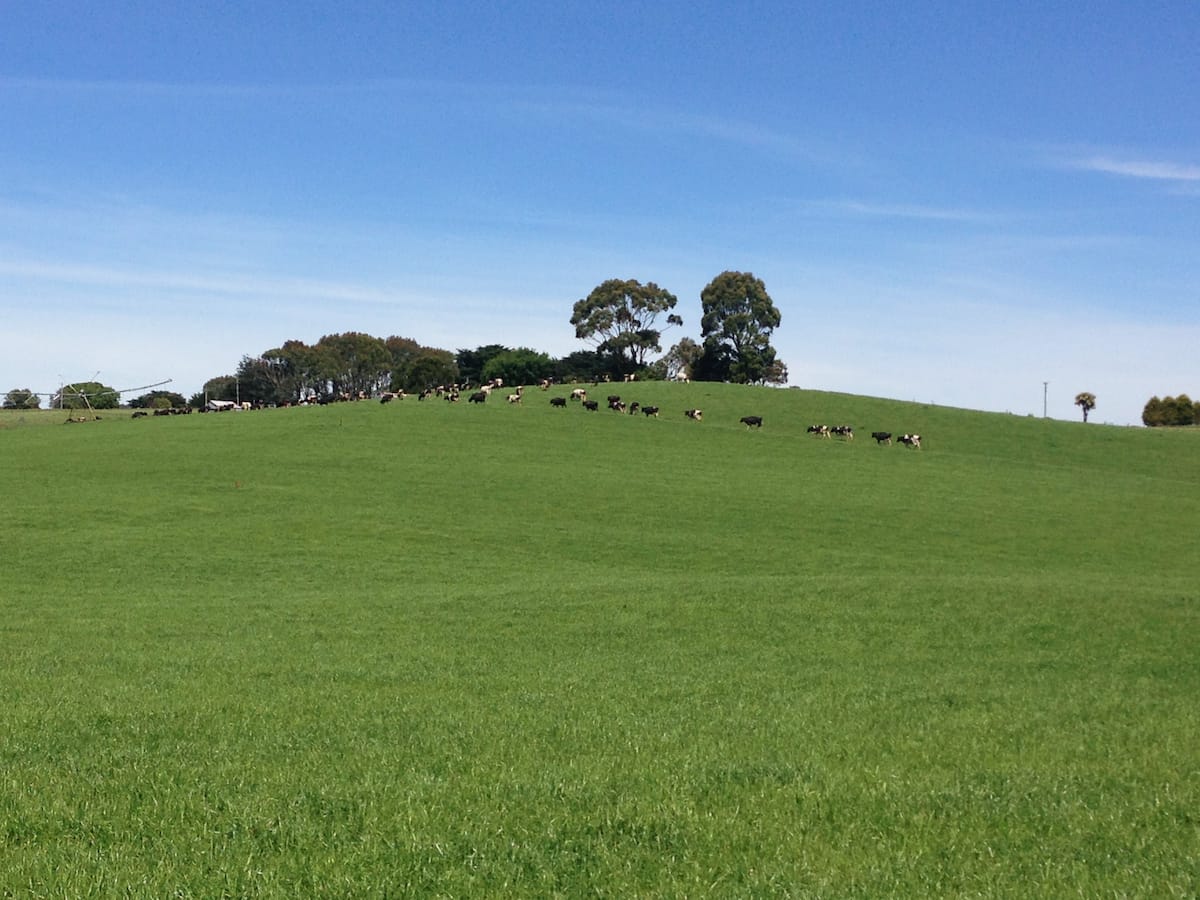
Research studies show that grazing schedules based on how much herbage each paddock has at any given time is a much better use of resources. This alone can help you increase production by 5% and increase profits by up to 15%.
So if you take away one thing today, remember that measuring your pasture and making effective grazing decisions based on this data can give you a real competitive advantage.
If you're wondering about how to measure your pasture, don't worry. I've written a free guide for you on that, already.
8. How to store your surplus as silage?
Silage is the most cost-effective way to store surplus pasture.
You will use forage harvesters and balers to harvest your paddocks; once dry matter yields reach more than 3,500 kilograms per hectare.
Typically, when harvesting silage, the crop will have about half its weight as dry matter and the remaining weight as moisture.
Why?
Because, over some time, lactic acid-producing bacteria, the same bacteria that makes sourdough bread and beer, starts dominating all other microbial growth.
It feeds on dangerous microbes such as E.Coli. This is why your silage will reach a stable state of decay under dry, airtight conditions.
There are two primary objectives that you need to keep in mind while harvesting silage. First, is to keep the costs low and secondly, to manage the quality of the silage.
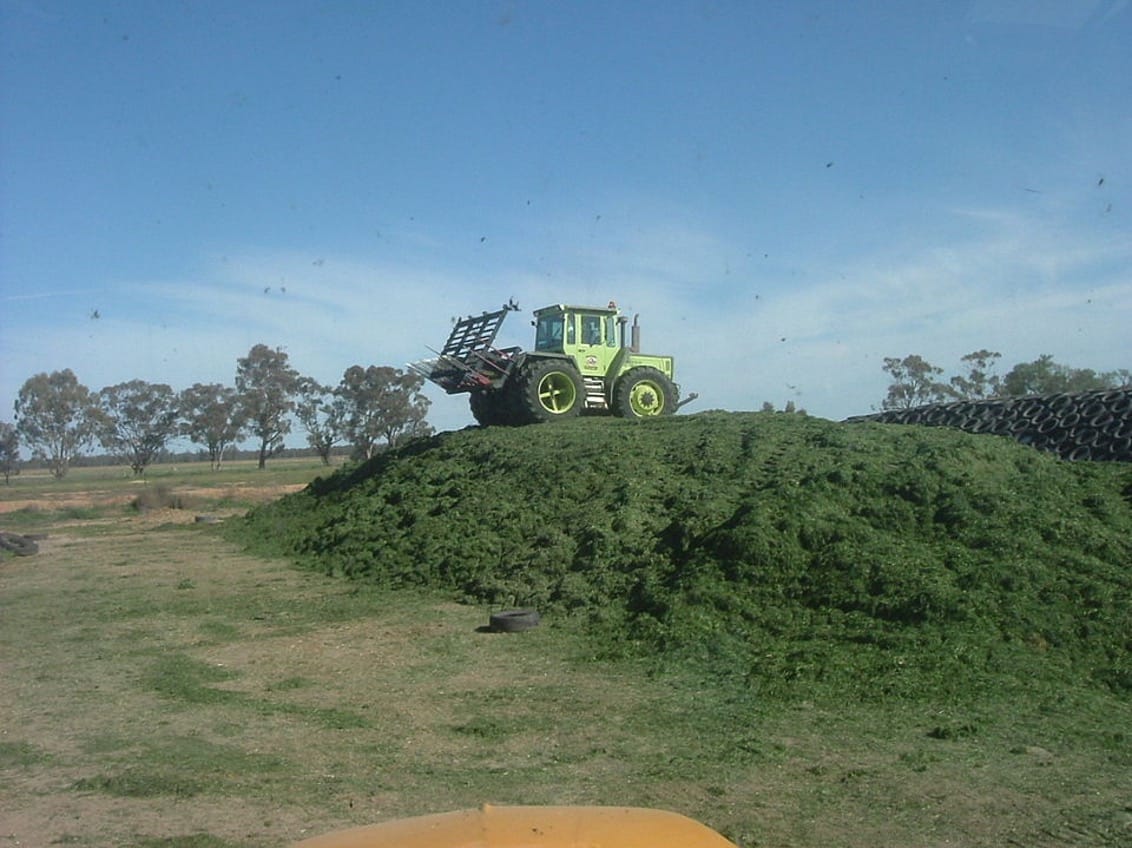
By hiring harvesters and balers to harvest silage from multiple paddocks at the same time, you can keep your overall cost per ton of silage low.
And by ensuring that you harvest surplus after it is sufficiently dry and before it starts wilting, you can reduce quality losses.
You need to plan in advance to achieve this. More specifically, you need to measure dry matter yields in all your paddocks accurately.
In addition to this, you also need to ensure that the silage is harvested and stored safely, without any contamination of dead animals or additional moisture.
Silage is the most cost-effective way of storing surplus pasture. You will use forage harvesters and balers to harvest your paddocks; once dry matter yields reach more than 3,500 kilograms per hectare. Typically, when harvesting silage, the crop will have about half its weight as dry matter and the remaining weight as moisture.
Why?
Because over some time, lactic acid-producing bacteria, the same bacteria that makes sourdough bread and beer, starts dominating all other microbial growth. It feeds on dangerous microbes such as E.Coli. This is why your silage will reach a stable state of decay under dry airtight conditions.
There are two primary objectives that you need to keep in mind while aiming to reduce wastage and maintain the quality of your pasture.
These objectives are:
Minimize the lactate accumulation – This can happen when there is a large production of CO2 in the silage which results in an excess of lactic acid. The bacteria will continue to produce more lactic acid as long as it has glucose and oxygen available.
A simple way to know if you have too much lactic acid would be to gauge its pH level. A pH reading below 5 implies that your silage may become rapidly putrefied, thereby destroying its nutritive value and making it toxic for ruminants. You need to try out different ways like adding cereal grains, or urea (which also help increase protein levels), to control such an occurrence.
9. An automatic, accurate and cheap way to measure your pasture
Congrats on making it so far. Most people don’t. By investing your time in learning how to manage your pasture, you are setting yourself up to earn better profits.
I’m a big believer in setting yourself up for success. For instance, you are much more likely to succeed with your diet when you don’t stock chips, rather than rely on willpower alone to do the right thing.
Right now, you know how important it is for you to manage your pasture, But, your priorities change, when you set foot into your farm, and unexpected problems crop up, you might not be so enthusiastic about measuring and managing your pasture. And trust me, neither will I.
Why? Because, we’re human and at the end of the day we have limited decision-making capacity. As a third generation dairy farmer in Australia, I know how problems on our farms creep up from nowhere.
This is why I started pasture.io, to help farmers like us, manage pastures effectively and earn more profits.
We help you measure your pasture, automatically. Yes, that’s right. You get automatic updates on your phone and computer, several times a week that show you which paddocks to graze next for best results.
But, quickly we realized that this alone was not enough. To help you manage your paddocks better, we now also help you plan your spraying, fertilizing, and sowing activities, based on data from your farm. In otherwords a digital paddock app that safely stores your records with no risk of your notes going through the washing machine.
For instance, we built the leaf emergence calculator, a tool to help you graze your pasture at the right leaf stage. To help you optimize grazing schedules and achieve quicker pasture regrowth.
With our nitrogen calculator you will now know how much Nitrogen your pasture needs, how much it will cost you and how it compares to the costs of buying feed from outside.
And with our area allocation calculator, you can quickly decide how much pasture you need to grow based on data from your farm, herd, local weather conditions and irrigation setup.
As you can see, we are building something that sets you up for success, to make it easier for you to take the right decisions, amidst your busy work day. But more importantly, it gives you a system that makes it harder for you to not manage your pasture effectively.
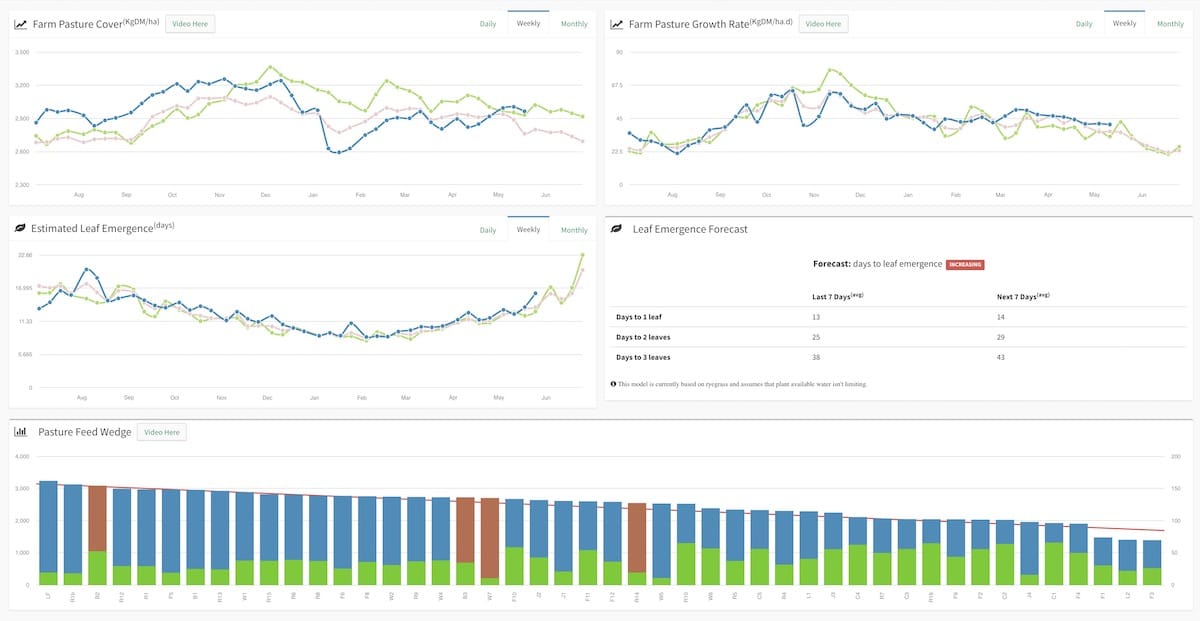
10. How to effectively manage your pasture, for less than $15 per hectare per year?
The traditional way of measuring a pasture is to measure with a rising plate meter. This includes using manual labour and logging the data. However, this method is not always accurate especially for distances, as they can be costly for resources and time. If you are interested in finding out information about your pasture without expending much effort, you can do so by using automated satellite measurements.
Automatic measurements rely on artificial intelligence and high-resolution satellite imagery. It relies on when cows last grazed a particular paddock as well as their last fertilizing date.
It also looks at regional and local weather data which includes factors such as seasonality and local weather changes. A benefit of automatic measurements is that it can be done from anywhere where there is the internet, and anywhere grass grows!
If conventional ways of measuring your pasture are too cumbersome and costly, you can consider an automatic pasture measurement service such as pasture.io. We use artificial intelligence and high-resolution satellite imagery to help you automatically measure pasture growth.
We also factor in local weather and your farm data. The weather data helps factor in seasonal weather changes, and the farm data helps factor other important local variables such as when your cows last grazed a particular paddock or when a paddock was last fertilized.
This means we can help you measure pasture growth until 3,500 Kg DM/ha with reasonable confidence to help you utilize surplus pasture effectively. And is something that other pasture growth measurement tools or services cannot offer.
We have a simple pricing structure. You play a flat fee of AUD 1,099 per year, and then pay AUD 8 per hectare per year. So, if you own 150 hectares, you will pay about AUD 15 per hectare per year. And in case you want something even more simple we also offer you a free plan that costs you nothing.
11. To sum it all up
It is important to realize that measuring your pasture is important, because it can earn you thousands of dollars in increased profit, every year.
No matter what you do or how you do it, measuring your pasture should be a non-negotiable for you. So start measuring your pasture today. And never stop doing it.
That said, using tools such as RPMs or a C-Dax meter might work well for you in case you are disciplined and well organized to spend a few hours every week, measuring your pasture, diligently.
But, if you are looking for something that is more accurate and convenient, you can consider electronic motes, drones or satellite tools.
Electronic motes are an expensive but a convenient option. Drones are a cost-effective and promising option that has a steep learning curve.
And satellite-based pasture measurement services such as pasture.io can give you automatic, accurate and cost effective pasture measurement updates several times a week.
12. Further reading resources
A number of independent researchers and organizations such as Dairy Australia, Meat & Livestock Australia, Dairy New Zealand, Ohio University have done extensive studies on the benefits of measuring and managing pastures, using a range of pasture measurement tools.
For further reading, please consider learning more about:
- The Dairy Feed Base project by Dairy Australia
- Grazing and pasture management resources by MLA
- The animal welfare and environmental benefits of Pasture
- Using Pasture Measurement to Improve Your Management
- The farm business case for feeding ruminants just on pasture
- How farmers could utilize more pasture to produce more profitable milk
- Benefits of accurately allocating feed on a daily basis to dairy cows grazing pasture
- Welfare-positive management and nutrition for the dairy herd: a European perspective
- Practical recommendations to manage supplements for pasture grazed cattle
- Inclusion of forage mixtures in the diet of growing dairy heifers
- Sustainable Grasslands, a working paper by FAO
13. The Ultimate Collection of Pasture Management Articles
We're growing the greatest homegrown and ultimate one-stop collection on pasture management.
Check out our articles and feel free to suggest more:
- Grazing tips for winter conditions: "wait, you feed out on the road?"
- How to use Pasture.io to get maximum yields and nutritional value out of your pastures
- How to use the leaf stage to make grazing decisions
- Entering grazing records and planning your grazing activities in advance
- How to use pre-grazing and post-grazing targets to make effective grazing decisions
- Winter pasture grazing tips - reducing soil compaction
- Pasture Utilisation a Key Driver of Farm Profitability
- Harvesting Lucerne as silage
- All about Pasture Utilisation
- How to fertilise your pasture the right way (Part 1)
- How to fertilise your pasture the right way (Part 2)
- How to fertilise your pasture the right way (Part 3)
- Stop eyeballing your pasture growth and start earning more profits
- Perennial Ryegrass Grazing Management
- Why You Need To Set Pre And Post-Grazing Targets Now!
- Manage Your Pastures with Precision to Improve Animal Nutrition
- Increase your pasture utilisation and make thousands of dollars every year
- Three Amazing Warm Season Grasses
- How to Manage Your Pasture By Seasons
- Why You Should Consider Pasture Reseeding For Your Cattle
- The latest tips to best pasture management for you and your farm
- How to increase your farm profit through pasture management?
- Topping Pasture: is it worth it?
- Timely Grazing: Key to Effective Spring Pasture Management












































